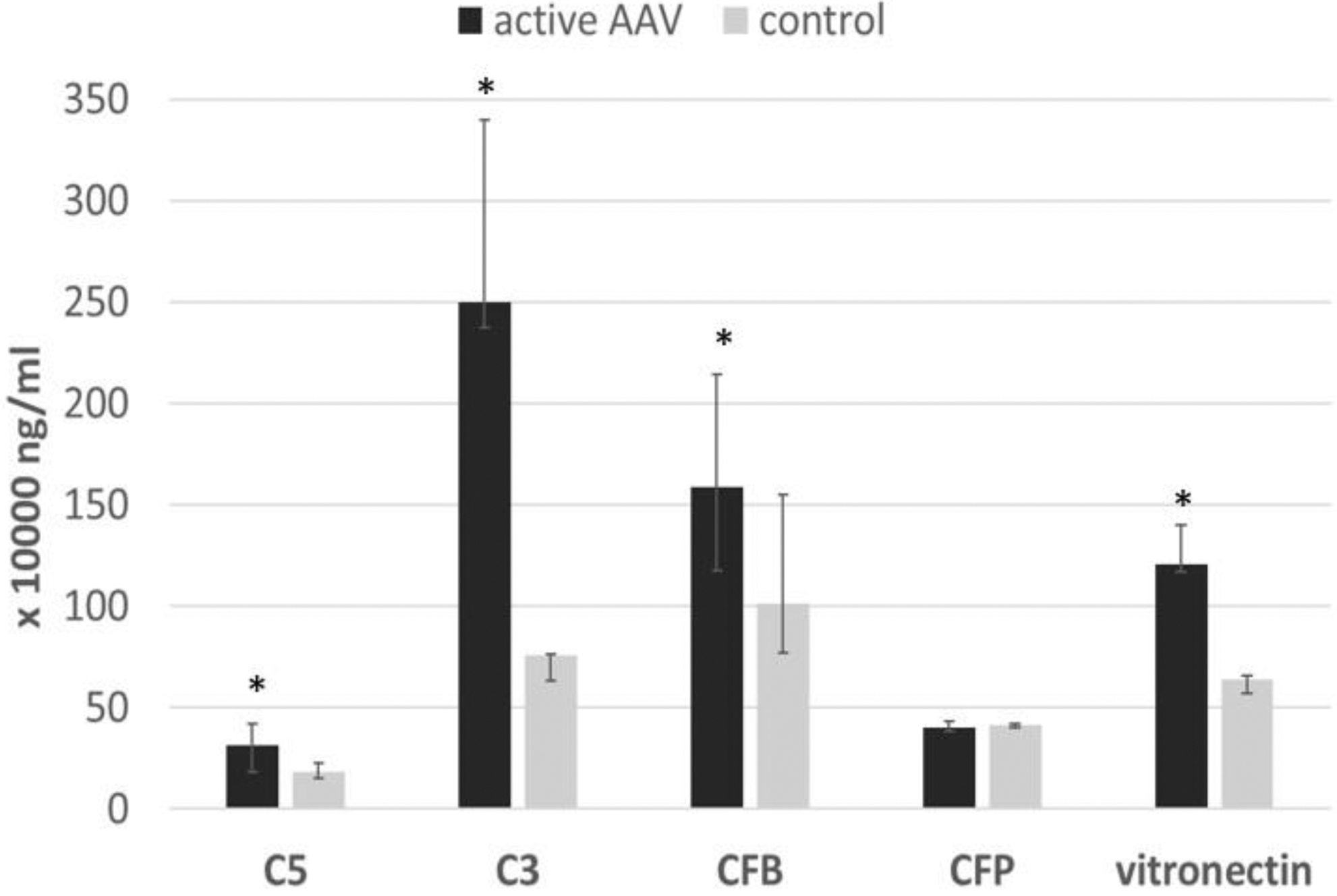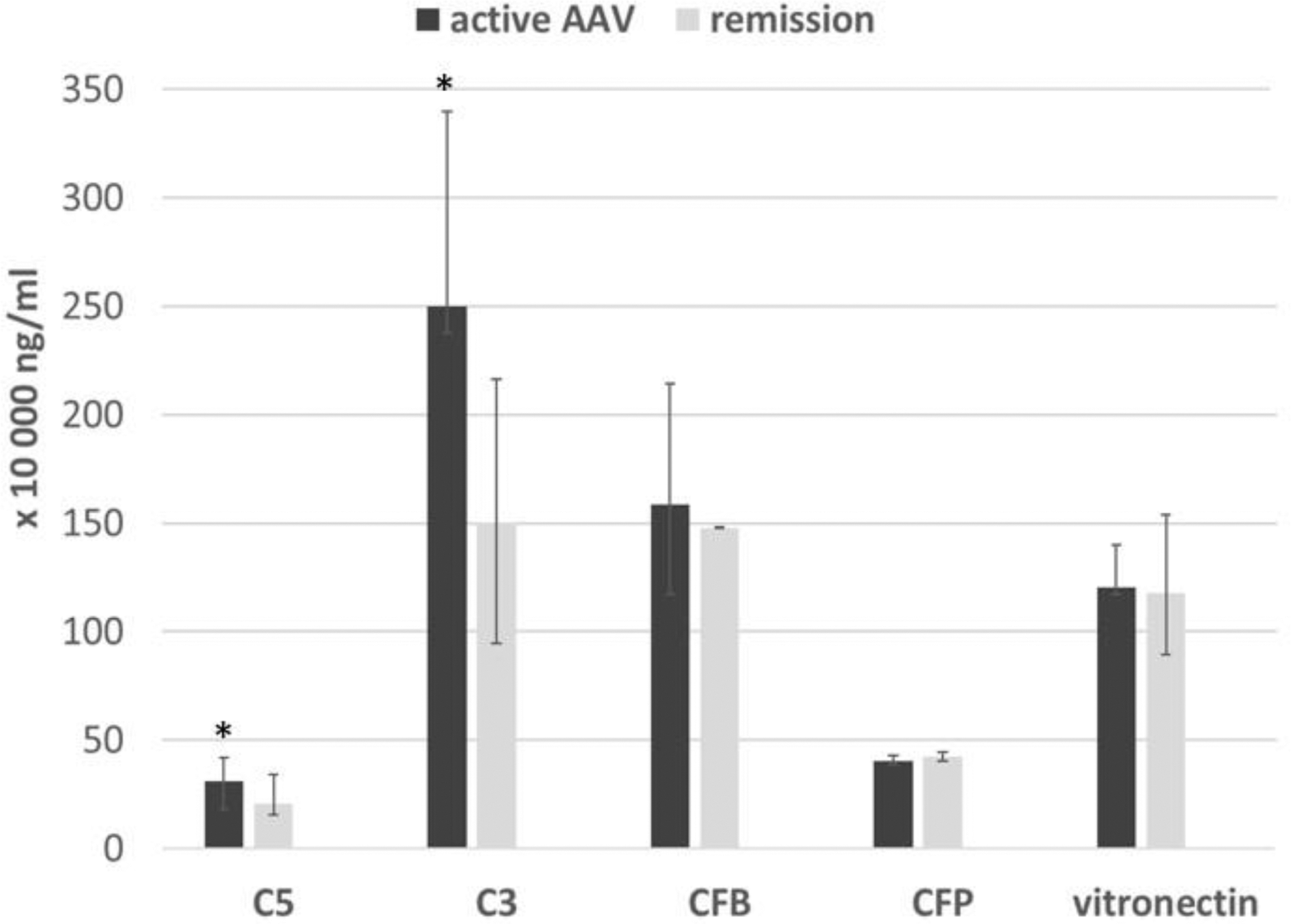

Background: There is increasing evidence that the complement system, in particular the alternative pathway, plays a crucial role in the pathogenesis of ANCA-associated vasculitis (AAV) [1]. Efficacy of C5a receptor antagonists indicates that chemoattraction mediated by C5a plays a key role in the inflammatory process observed in AAV [2]. Another promising research object are regulatory proteins such as factor B [3].
Objectives: To study complement activation via the alternative pathway in patients with active ANCA-associated vasculitis.
Methods: 59 patients with newly diagnosed (n=35) or relapsing GPA or MPA (n=24) were enrolled in this prospective study. Median BVAS v.3 at the time of AAV onset was 16.5 (9.5; 20). In 28 patients activation of complement was reassessed during sustained remission (BVAS v.3 = 0) after a median of 16 months. Thirty six age-and gender-matched healthy volunteers comprised the control group. Levels of complement components (C3, C5, C3a, C5a, vitronectin, factor B and factor P) were measured by ELISA (Cloud Inc.). Data were not normally distributed, therefore, values are given as medians and IQRs and nonparametric statistical tests were used.
Results: The concentrations of C5, C3, vitronectin and CFB were significantly higher in patients with active AAV than control group. There were no significant differences in the levels of factor P in patients with active AAV and control group (388000 (371960; 417150)) vs 416000 (400200; 437000), ng/ml, p >0.05) (
Concentration of complement components in patients with active AAV and healthy controls (*p<0.05)

Serum level of C5a and C3a were higher in patients with active AAV than in healthy controls (22.9 (14.4; 33.0) vs 3.0 (0.35; 6.73), ng/ml, p<0.001; 21436 (11395; 21436) vs 1224.5 (798.5; 1947.7), ng/ml, p<0.001). Patients with active AAV had significantly higher MAC levels than healthy controls (24646 (15342; 46681) vs 3305.5 (2780.2; 3777.5), mAU/ml, p<0.001).
The levels of complement components were similar in PR3-ANCA and MPO-ANCA disease, and severe and non-severe AAV. C5a/C5 and C3a/C3 ratios were not influenced by disease activity, severity or ANCA type.
After immunosuppressive treatment concentrations of C5, C3, and their activated products, C5a, C3a significantly decreased (
Concentration of complement components in patients with active disease and remission (*p<0.001)

Conclusion: The complement system plays an important role in AAV. While treatment affects some component, some remain unchanged and are not dependent on AAV severity or ANCA serotype.
REFERENCES:
[1]Jennette JC, Xiao H, Hu P. Complement in ANCA-Associated Vasculitis. Seminars in Nephrology 2013; 33 (6): 557 – 564
[2]Schreiber A, Xiao H, Jennette JC et al. C5a receptor mediates neutrophil activation and ANCA-induced glomerulonephritis. J Am Soc Nephrol 2009; 20(2): 289-298.
[3]Gou SJ, Yuan J, Chen M et al. Circulating complement activation in patients with anti-neutrophil cytoplasmic antibody-associated vasculitis. Kidney Int 2013; 83(1): 129-137.
Disclosure of Interests: Anastasiia Zykova Grant/research support from: This work was supported by the 5-100 Project, Sechenov University, Moscow, Pavel Novikov Grant/research support from: This work was supported by the 5-100 Project, Sechenov University, Moscow, Nikolai Bulanov Grant/research support from: This work was supported by the 5-100 Project, Sechenov University, Moscow, Andreas Kronbichler Grant/research support from: This work was supported by unrestricted grant from the Austrian Society of Rheumatology., Evgeny Gitel: None declared, Oxana Novikova: None declared, Mayra Bulanova: None declared, Elizaveta Safonova: None declared, Sergey Moiseev Grant/research support from: This work was supported by the 5-100 Project, Sechenov University, Moscow